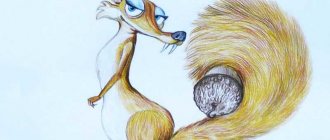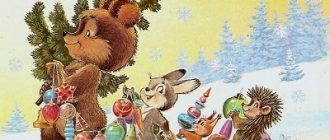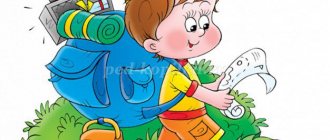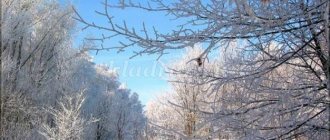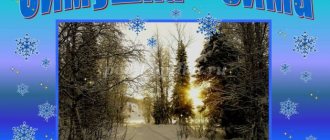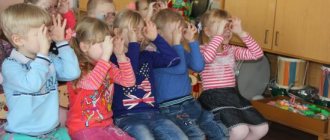Thematic music lesson for older preschoolers “In the circus arena”
Summary of thematic music lesson in the senior group “In the Circus Arena”
I offer this summary to music directors for children of senior preschool age. The material can be used by teachers of senior and preparatory groups on the topic “Professions”. It is recommended to replace the information about the Donetsk circus with material relevant to your area. Author: Kudryavtseva Irina Viktorovna, preschool educational institution No. 287 “Teremok”, Donetsk. Goal: To familiarize children with the professions of people performing in the circus. Objectives: To enrich and expand children's knowledge about the professions of people performing in the circus, to provide them with the opportunity to feel the significance of each profession. Continue to enrich and activate children's vocabulary, develop their speech. Practice the ability to convey various emotions using facial expressions and gestures. To develop children's creative independence in creating an artistic image, to encourage them to look for expressive means to create it. To instill in children respect for artists performing in the circus; sustainable interest in theatrical and gaming activities; desire to take part in theatrical performances. Methods and techniques used in the lesson: Verbal:
story, conversation, artistic expression.
Visual:
slide show with images of circus performers.
Practical:
exercises to practice facial expressions, gestures, theatrical play.
Materials and equipment: musical accompaniment;
multimedia system; photographs depicting circus performers; portrait of D. Kabalevsky; items for the communicative game “At the Circus” (jump ropes or ropes, balls, a magician’s hat with a magic box, weights (proper), clown wigs), surprise coloring books. PROGRESS OF THE CLASS.
Children enter the hall to the “March” of the circus orchestra and sit down in their seats. Greeting “Good morning” by O. Arsenevskaya Good morning, smile quickly, And today the whole day will be more fun. Musical director: Guys, do you like the circus? (Answer: Yes!)
What is it?
(Answer: The place where the performers perform.)
Where do the performers perform in the circus?
(Answer: In the arena.)
What is the shape of the arena?
(Answer: Round.) A slide with an image of a circus arena is projected onto the screen.
Musical director: Do we have a circus in Donetsk? Who knows what it's called? (Answer: Space.) A slide with an image of the Donetsk Circus “Cosmos” is projected onto the screen.
Musical director: Guys, how can we find out that there will be a performance at the circus? (Answer: On the poster.)
That's right, it is on the poster that it indicates which city the circus came from and what time the performance will take place.
Musical director: And now we will imagine what happens at the circus in the morning. Chant “In the morning at the circus” text not the author’s Teacher: 1. In the morning at the circus, the animals in the cage wake up Like echoing a cuckoo Chorus: Teacher: She sings “KU - KU”! And the cockatoo: Children: “KU - KU”! Teacher: She sings: “KU - KU” Pig in response: Children: “Oink - Oink” Teacher: She sings: “KU - KU” Cow to her: Children: “MU - MU” Teacher: And only the owl - the owl Grumbles, that it’s time to sleep, After all, owls go to bed during the day and at night they need to get up. Teacher: 2. And not only animals respond in the morning. They also sing the same chorus before the performance. Teacher: And only the elephant doesn’t sing, He rubs his nose and rubs it. Yesterday he got his feet wet and this upset his mother. Musical director: We’ll sing an echo song about an elephant now. Repeat after me. Everything will work out for us. Sing clearly, clearly Songs and words, So that everyone in the circus can hear, Every person. “Echo Song” text not the author’s First, the music director sings the phrase, then the children repeat.
Once a little elephant caught a cold and then the mother elephant roared: “What should we do?
That’s the trouble.” Papa Elephant said calmly: “What are you doing? No need to cry! Just teach the baby elephant to wipe his nose with his nose. Musical director: Guys, now we have sung songs whose main characters are animals. Do any of you remember the name of the profession of people who work in a circus with animals? (Answer: Trainers.)
They usually take animals when they are still babies, take care of them, educate them, know the habits of the animals well and love them very much.
The trainers are very patient and brave people. Imagine, guys, they are not afraid to enter a cage with tigers, what brave people they are. Trained animals understand and love their owner-friend and fulfill his requirements. Name the animals the trainer works with. (Children’s answers. Slides with images of trainers are projected onto the screen.)
Musical director: Would you like me to guess which of the circus performers you like best? These are clowns. Now we will listen to a play by D. Kabalevsky (a portrait of the composer is shown)
, which is called “Clowns”.
Listening to the play “Clowns” by D. Kabalevsky. Musical director: What kind of clowns did the composer portray in his music? (Answers: Cheerful, fast, funny, nimble.)
Listen to the play again and imagine what they can do to this music?
(Answers: Run, jump, make faces, fall, laugh, etc.)
Clowns always have a bright costume and makeup on their face, so that the audience can clearly see his facial expressions when he cries, or laughs, or is surprised, or afraid.
Let's use our facial expressions to depict how the clown is upset, crying, afraid, surprised, happy. (Children show.)
And now I will play music of different moods, and you guys will try to reflect it with your facial expressions and gestures.
Improvisation for the development of facial expressions. Musical director: Here's a look at the photos of what clowns can look like. A slide with an image of clowns is projected onto the screen.
Musical director: Of course, clowns always make the audience laugh and that’s why they laugh most often. Breathing exercises “The clown laughs” Children take in air and, as they exhale, imitate the clown’s laughter with the syllables “ha”, “hee”, “ho”. Musical director: Guys, there are, of course, a lot of professions of artists in the circus. These include acrobats, performing complex tricks at great heights under the circus dome, both in the air and on the arena stage, and jugglers, deftly tossing various objects and even burning from very difficult body positions. And there are also strong men who can juggle weights and very heavy weights. (The story is accompanied by a projection of slides.)
Musical director: It’s not for nothing that we are talking about the circus today during a music lesson, because not a single circus performance can take place without music. Every circus has an orchestra that accompanies all the performers. Now we are going to the circus. We won’t be able to go there, but we will try to invite the circus here. How many of you know the name of the circus that is moving? (Answer: Tent.)
I offer to show you a circus performance for me.
To do this, you must become tightrope walkers, jugglers, magicians, strongmen, clowns. (Each of the children is assigned a profession.) Musical communicative game “At the Circus” (author unknown) Objects are laid out in the center of the hall - jump ropes or ropes, balls, a magician’s hat with a magic box, weights (professional), clown wigs.
Children walk in a circle while singing, pretending to be circus performers to lose. 1. We have a lot of fun at the circus, We laugh and laugh.
We walk on a tightrope, we will never fall. 2. We have a lot of fun at the circus, We laugh and laugh. We are juggling balls, throw them with us. 3. We have a lot of fun at the circus, We laugh and laugh. An expert in performing magic tricks. Illusionist and magician. 4. We have a lot of fun at the circus, We laugh and laugh. In the arena, strongmen squeeze weights like rolls. 5. We have a lot of fun at the circus, We laugh and laugh. The clown rushes into the arena - the spectator laughs merrily. 6. We have a lot of fun at the circus, We laugh and laugh. The show is over. Who watched - well done. Musical director: Guys in the circus, people work in different professions. They are specially trained for these professions. These are brave, determined and kind people. With their work they bring joy, fun and good mood to the audience. What new things have you learned about the circus today? What did you like about the lesson? (Children's answers)
I have a little gift for you, this clown coloring book.
(Coloring books are handed out to the children.) Musical director: Finally, we will walk around the arena one more time, To everyone who smiles in the hall, That’s right, we will meet more than once. The children once again go around the hall to the music of “CIRCUS” (words by M. Plyatskovsky, music by V. Shainsky), and say goodbye.
Text application.
Greeting “Good morning” by O. Arsenevskaya Good morning, smile quickly, And today the whole day will be more fun. Chant “In the morning at the circus” Teacher: 1. In the morning at the circus, the animals in the cage wake up Like echoing the cuckoo Chorus: Teacher: She sings “KU - KU”! And the cockatoo: Children: “KU - KU”! Teacher: She sings: “KU - KU” Pig in response: Children: “Oink - Oink” Teacher: She sings: “KU - KU” Cow to her: Children: “MU - MU” Teacher: And only the owl - the owl Grumbles, that it’s time to sleep, After all, owls go to bed during the day and at night they need to get up. Teacher: 2. And not only animals respond in the morning. They also sing the same chorus before the performance. Teacher: And only the elephant doesn’t sing, He rubs his nose and rubs it. Yesterday he got his feet wet and this upset his mother. Musical director: We’ll sing an echo song about an elephant now. Repeat after me. Everything will work out for us. Sing clearly, clearly Songs and words, So that everyone in the circus can hear, Every person. “Echo song” First, the music director sings the phrase, then the children repeat it.
Once a little elephant caught a cold and then the mother elephant roared: “What should we do?
That’s the trouble.” Papa Elephant said calmly: “What are you doing? No need to cry! Just teach the baby elephant to wipe his nose with his nose. Breathing exercises “The clown laughs.” Children take in air and, as they exhale, imitate the clown’s laughter with the syllables “ha,” “hee,” “ho.” Musical communicative game “At the Circus” (author unknown) Objects are laid out in the center of the hall - jump ropes or ropes, balls, a magician’s hat with a magic box, weights (for props), clown wigs.
Children walk in a circle while singing, pretending to be circus performers to lose. 1. We have a lot of fun at the circus, We laugh and laugh.
We walk on a tightrope, we will never fall. 2. We have a lot of fun at the circus, We laugh and laugh. We are juggling balls, throw them with us. 3. We have a lot of fun at the circus, We laugh and laugh. An expert in performing magic tricks. Illusionist and magician. 4. We have a lot of fun at the circus, We laugh and laugh. In the arena, strongmen squeeze weights like rolls. 5. We have a lot of fun at the circus, We laugh and laugh. The clown rushes into the arena - the spectator laughs merrily. 6. We have a lot of fun at the circus, We laugh and laugh. The show is over. Who watched - well done. Musical director: Finally, we will walk around the arena again, Everyone who smiles in the hall, That’s right, we will meet more than once.
We recommend watching:
Summary of GCD in the senior group “Northern Adventures” Integrated lesson with a presentation for children of the senior group on the topic: Autumn Music lesson in the senior group with TRIZ elements: Seasons Integrated music lesson using health-saving technologies in the senior group
Similar articles:
Musical lesson using logorhythmics in the senior group of a preschool educational institution
Rhythm lesson for middle and senior kindergarten groups
Musical lesson in the senior group. Abstract
Summary of the lesson “Birds in winter.” Senior group
Complex lesson in the senior group of kindergarten according to the Federal State Educational Standard
Tasks:
Educational: consolidate children's knowledge about different emotions (joy, sadness, surprise);
Educational: develop in children the ability to express their emotions through facial expressions;
Correctional: teach children to recognize the emotion “surprise” and describe it verbally using pictograms.
Equipment: tape recorder; music cassette; sheets of white paper; magnetic boards; images of a sad and cheerful clown; pictures of sad, happy and surprised animals; laser pointer; “surprise” pictograms; cards with the image of joy; cape; "Magic wand"; 3 jars; candles; gouache, brushes, napkins; sheet with a hidden image.
